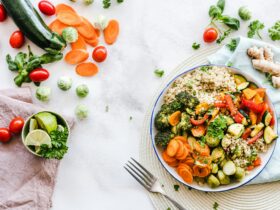Chronic diseases such as heart disease, type 2 diabetes, stroke, certain cancers, and dementia develop over years, often quietly. Food choices accumulate just as quietly. A single meal rarely transforms your health, yet the pattern you follow every week shapes blood pressure, blood sugar, inflammatory tone, gut microbiome diversity, and body weight. The good news is that prevention is not about perfection. It is about consistent patterns that favor whole foods, fiber, healthy fats, thoughtful protein choices, and mindful amounts of salt and sugar. This guide translates the strongest nutrition principles into daily habits you can actually keep.
Think in Patterns, Not Just Nutrients
Nutrition science sometimes sounds like a long list of isolated nutrients. Real life is simpler when you think in terms of dietary patterns. Patterns such as Mediterranean, plant-forward DASH style eating, or traditional diets built around vegetables, legumes, whole grains, fruit, nuts, seeds, herbs, spices, and seafood consistently show protective effects. These patterns deliver a high fiber load, a wide mix of phytonutrients, unsaturated fats from olive oil, nuts, and fish, and modest amounts of animal products. They are also naturally lower in sodium, added sugars, refined starches, and ultra-processed food. The lesson is to build most meals around plants, include quality fats and proteins, and reserve rich or highly processed foods for occasional use.
Fiber Is Your Daily Shield
Fiber is not only for digestion, it is a central tool in disease prevention. Soluble fiber forms a gel that slows digestion, steadies the rise in blood glucose, and binds bile acids which can lower LDL cholesterol. Insoluble fiber gives bulk, supports regularity, and dilutes potential carcinogens in the colon. Fermentable fibers feed friendly gut bacteria that produce short chain fatty acids such as butyrate. These compounds strengthen the intestinal barrier, reduce inflammation, and may influence appetite regulation and insulin sensitivity.
Aim for a minimum of 25 to 38 grams of fiber per day, although many people benefit from even more if they increase gradually and hydrate well. Good sources include beans, lentils, chickpeas, oats, barley, quinoa, brown rice, whole grain breads with visible seeds, berries, apples, pears, oranges, leafy greens, broccoli, Brussels sprouts, carrots, nuts, seeds, and ground flax. If you currently get little fiber, raise your intake over two to three weeks to avoid discomfort while your microbiome adapts.
Carbohydrates That Work For You
Carbohydrates are not the enemy. The issue is how quickly carbohydrate foods digest and how much fiber and micronutrient value they bring along. Refined starches and sugars rush into the bloodstream which stresses the pancreas and over time can worsen insulin resistance. Carbohydrates packaged with intact fiber, water, and structure digest more slowly and satisfy longer. Choose intact whole grains more often than flours. Think steel cut or old-fashioned oats, cooked barley, buckwheat, brown rice, quinoa, whole farro, and corn off the cob over products made with refined flour. When bread is on the menu, pick versions with whole, sprouted, or seeded grains, and pair bread with protein or olive oil to blunt blood sugar spikes.
Fruits are valuable because their fiber and polyphenols deliver more than their natural sugars would suggest. Whole fruit supports satiety and brings potassium, vitamin C, and diverse phytochemicals. If juice is used, keep portions small and treat it as a flavor accent. Vegetables, especially leafy greens and cruciferous varieties, should be the base of most plates. Their high water and fiber content alongside vitamins, minerals, and protective compounds make them the carbohydrate source your body welcomes daily.
Fats That Protect, Fats To Limit
Fat is essential for absorbing fat-soluble vitamins and building cell membranes and hormones. The type of fat matters more than the total grams for most people. Emphasize monounsaturated and polyunsaturated fats from olive oil, avocado, nuts, seeds, and fish. These fats support favorable lipid profiles and may reduce cardiovascular risk. Omega-3 fats from salmon, sardines, mackerel, trout, anchovies, and from plant sources like walnuts, chia, and flax help lower triglycerides and may dampen chronic inflammation.
Saturated fat from fatty meats and high fat dairy can raise LDL cholesterol in many individuals. Context matters though, since overall dietary pattern, fiber intake, and food source influence risk. It is reasonable to keep saturated fat modest and to obtain it primarily from minimally processed foods such as yogurt or cheese in small portions rather than from ultra-processed baked goods. Trans fats are best avoided entirely, which is easier now that industrial trans fats have been phased out in many regions, although small amounts can still appear in some processed items.
Protein Quality and Quantity
Protein supports muscle maintenance, immune function, and metabolic health. For long-term disease prevention, quality sources that bring additional benefits are ideal. Beans, lentils, tofu, tempeh, edamame, peas, nuts, seeds, eggs, fish, and poultry can meet needs for most people. Plant proteins often come packaged with fiber and phytochemicals and tend to displace less healthy foods, which confers advantage. Fatty fish offers protein plus omega-3s. Yogurt and kefir provide protein along with beneficial microbes and calcium which supports blood pressure and bone health.
Many adults under eat protein at breakfast and lunch then overeat it at dinner. Distribute intake across the day to support satiety and muscle maintenance, especially if you are over 40 or physically active. Combine plant and animal sources according to your preferences, budget, and culture. The goal is not a number on a tracker, it is a steady rhythm of satisfying meals that prevent overeating later.
Sodium, Potassium, and Blood Pressure
Hypertension quietly damages blood vessels and organs. Salt reduction is one of the most reliable tools to lower blood pressure, especially when paired with a diet rich in potassium, magnesium, and calcium. Most dietary sodium comes from restaurant and packaged foods rather than the salt shaker. Cooking more at home, choosing items labeled low sodium, and flavoring food with citrus, herbs, spices, and vinegar can cut sodium substantially. Foods high in potassium include bananas, oranges, potatoes, sweet potatoes, tomatoes, beans, lentils, leafy greens, beets, and dried fruits. Dairy, nuts, seeds, and greens provide magnesium and calcium. The combination of more plant foods and fewer ultra-processed products naturally shifts this mineral balance toward a blood pressure friendly profile.
Added Sugar and Refined Flour
Added sugar sweetens life but undermines long-term health when it becomes a daily habit. Sugar does not cause disease on its own, yet it displaces nutrient dense foods and encourages overconsumption because it rarely satisfies hunger for long. Refined flour behaves similarly in the body since it digests quickly. Focus on swaps rather than bans. Choose yogurt with no added sugar and add fruit and cinnamon. Replace sweetened cereal with oatmeal or muesli. Bake with less sugar and more spice. Drink water, sparkling water with citrus, unsweetened tea, or coffee with minimal sweetener. When sweets are part of celebrations, enjoy mindfully and resume your usual pattern at the next meal.
The Anti-inflammatory Plate
Chronic low grade inflammation is a common thread linking heart disease, diabetes, arthritis, and cognitive decline. Food is not the only factor, yet a diet rich in colorful plants, omega-3 fats, herbs, and spices can modulate inflammatory signaling. Think of a typical lunch featuring leafy greens, tomatoes, cucumbers, olives, chickpeas, a drizzle of extra virgin olive oil, seeds for crunch, and a piece of fruit. Season dinner with turmeric, ginger, garlic, rosemary, oregano, cumin, or cinnamon. These culinary herbs contain compounds that have been studied for their potential to influence oxidative stress and inflammatory pathways. The goal is to make flavor your ally and to let culinary traditions from around the world guide you.
The Gut Microbiome as a Health Partner
Your digestive tract hosts trillions of microbes that interact with your immune system, metabolism, and even your mood. Diversity in plant foods feeds a diverse microbiome. Set a simple challenge to eat at least thirty different plant foods each week. Count fruits, vegetables, whole grains, beans, nuts, seeds, herbs, and spices. Fermented foods such as yogurt, kefir, sauerkraut, kimchi, miso, and tempeh contribute beneficial microbes. As your microbiome becomes more robust, many people notice improvements in digestion, energy, and cravings, which makes preventive eating easier to sustain.
Meal Timing, Sleep, and Metabolic Rhythm
Nutrition does not operate in isolation. Late heavy meals close to bedtime can impair sleep and glucose regulation. Chaotic eating patterns that swing between skipping meals and grazing on refined snacks drive energy crashes and cravings. A regular meal rhythm that aligns with your waking hours supports insulin sensitivity and appetite control. Many people feel best with a solid breakfast that includes protein, fiber, and healthy fat. Lunch can be the anchor, especially if afternoons are long. Evening meals are most helpful when they are satisfying but not heavy and when there is enough time before sleep for digestion to begin. Hydration throughout the day supports blood pressure control and digestion. Sleep quality in turn influences hunger hormones, so a calm evening routine becomes part of nutrition for prevention.
Cooking Methods and Kitchen Skills
How you cook matters. Frying at high temperatures or charring meat can create compounds that are not friendly to long-term health. Baking, roasting at moderate heat, sautéing, poaching, steaming, pressure cooking, and slow cooking preserve nutrients and reduce harmful byproducts. Olive oil is stable for everyday cooking. If you enjoy grilling, use marinades with herbs, citrus, or vinegar and avoid excessive charring. Building a small repertoire of reliable recipes makes preventive eating feel automatic. Think hearty soups with beans and vegetables, one-pan roasted trays of mixed vegetables with salmon or tofu, whole grain bowls with greens and tahini dressing, simple omelets with mushrooms and spinach, and fruit with yogurt and nuts for dessert.
Shopping and Planning Without Stress
Prevention thrives on planning. Choose two or three breakfast options you enjoy. Stock the ingredients so mornings are effortless. Plan a few lunches that travel well such as a whole grain salad with chickpeas and chopped vegetables, or leftover roasted vegetables with a portion of chicken or tempeh. For dinner, pick three default meals for busy nights and one recipe to explore on weekends. Build a shopping list around vegetables, fruits, whole grains, legumes, nuts, seeds, eggs, yogurt or kefir, fish or poultry if you eat them, and pantry staples like olive oil, canned tomatoes, herbs, and spices. When life gets hectic, purchase a healthy rotisserie chicken or the plant-based equivalent, add a bagged salad and whole grain bread, and you are still aligned with prevention.
Weight, Waist, and Gentle Control
Excess adiposity, especially around the waist, raises risk for many chronic diseases. Restrictive dieting can backfire by slowing metabolism and igniting cravings. A prevention approach focuses on satiety and sustainability. Build plates that are half vegetables, add a portion of protein that fits your palm, include a serving of intact whole grains or starchy vegetables, and finish with healthy fat for flavor and fullness. Eat slowly, notice hunger and fullness cues, and reduce distractions during meals. Over time, these habits naturally regulate appetite. If weight loss is appropriate for your health plan, modest losses of five to ten percent of body weight can significantly improve blood pressure, lipids, and glucose control, and can often be achieved through these pattern shifts without extreme tactics.
Special Considerations by Life Stage
During pregnancy and lactation, nutrient density, adequate protein, omega-3 fats, iron, iodine, calcium, and folate become central. In childhood and adolescence, patterns that normalize vegetables, fruit, beans, and whole grains set a foundation that travels into adulthood. For older adults, protein distribution, calcium, vitamin D, B vitamins, and hydration need attention as appetite and thirst cues may fade. At every stage, cultural foods and family traditions can be honored and adapted. Prevention works best when it feels like home, not like a clinic.
Alcohol, Caffeine, and Pleasure Foods
Alcohol is best thought of as a sometimes item. Even modest intake raises risk for certain cancers. If you drink, do so sparingly and with food. Caffeine can be part of a healthy pattern for many, particularly in coffee and tea which contain beneficial polyphenols. Large sugary coffee beverages or energy drinks undermine prevention goals. Desserts and fried foods can fit when they are occasional, portion aware, and enjoyed without guilt. A pattern is resilient when it includes room for celebration and taste memory. The goal is to avoid the all or nothing trap and to maintain momentum across ordinary weeks.
Reading Labels Without Obsession
Labels help you spot added sugars, sodium, refined flours, and long ingredient lists that indicate heavy processing. Shorter lists with recognizable ingredients are usually a better fit. Look for whole grains in the first ingredient position, check sodium per serving against your needs, and compare added sugar across similar products. Use labels for comparison rather than perfection. Over time, you will rely more on fresh ingredients and pantry staples and less on packaged meals.
A Day of Preventive Eating in Real Life
Imagine breakfast that combines protein, fiber, and healthy fat. You might prepare old-fashioned oats cooked with milk or a fortified plant milk, topped with chia seeds, walnuts, and sliced berries. Lunch could be a bowl with quinoa, roasted vegetables, mixed greens, chickpeas, and a spoon of hummus with olive oil and lemon. An afternoon snack might be a small apple and a handful of almonds. Dinner might feature salmon or a tofu steak with a tray of roasted broccoli and carrots, a side of brown rice, and a yogurt-herb sauce. Dessert could be fruit or a square of dark chocolate. This is not a script, it is a template you can modify with your own flavors and traditions.
Behavior Change That Sticks
Knowledge is not the whole story. Lasting change grows from systems and environments. Place fruit where you can see it. Keep washed greens and cut vegetables ready. Batch cook whole grains and legumes on weekends. Set a water bottle on your desk. Schedule grocery trips and protect them on your calendar. Eat with people whose habits you admire. Track progress with non scale victories such as energy, sleep, digestion, and mood. Expect setbacks and plan a default meal for nights when nothing goes right. Compassion is a powerful motivator. You will return to a plan that respects your humanity.
Myths to Let Go Of
You do not need a cleanse to reset health. Your liver and kidneys are the body’s built-in detox system, which works best when you supply fiber, hydration, and adequate protein. You do not need to fear all carbohydrates. You need to choose the right ones and pair them with protein and fat. You do not need exotic superfoods to prevent disease. You need a steady rhythm of ordinary foods prepared with care. You do not need to eat perfectly every day. You need to show up most days with a pattern that matches your goals.
Bringing It All Together
Preventing chronic disease through nutrition is less about rigid rules and more about direction. Move toward meals that are mostly plants, rich in fiber and color, balanced with quality proteins, and finished with healthy fats. Keep sodium and added sugars modest. Favor cooking methods that respect your ingredients. Align meal timing with sleep and daily rhythm. Protect routines with planning and kindness to yourself. Over months these choices calm blood pressure, improve lipids, steady glucose, reduce inflammatory load, and support a healthy weight. The change is quiet at first, then unmistakable. Your future self benefits from the meals you build today, and the people you love are likely to follow your lead when they see how good you feel.








Leave a Reply